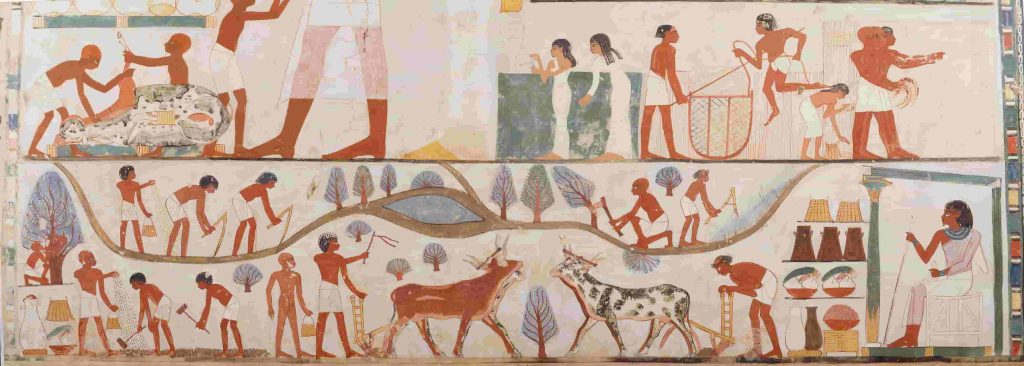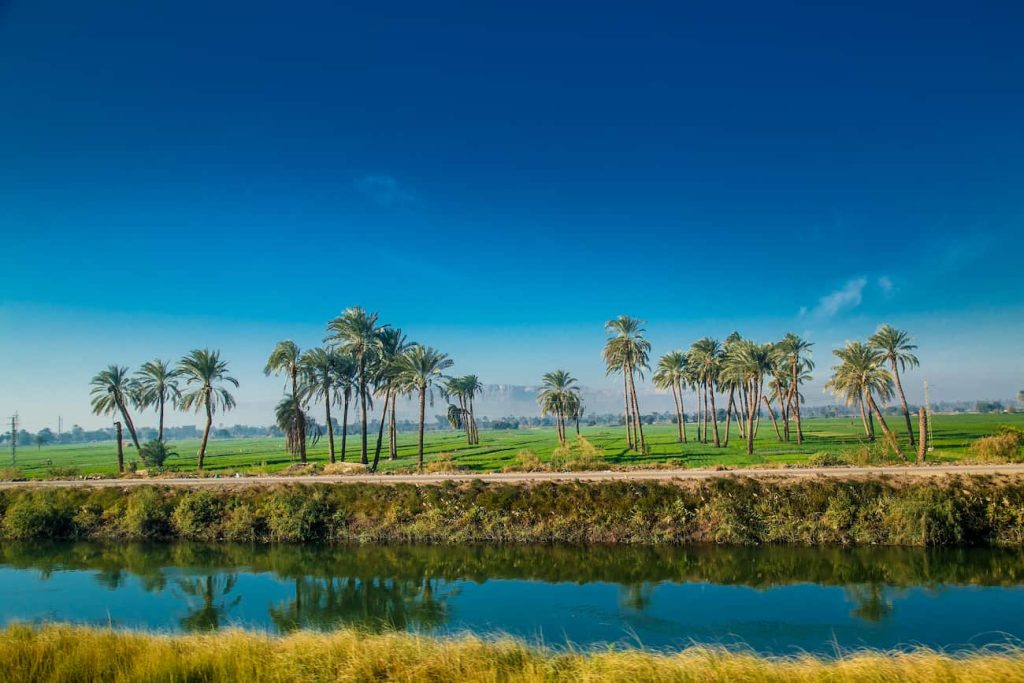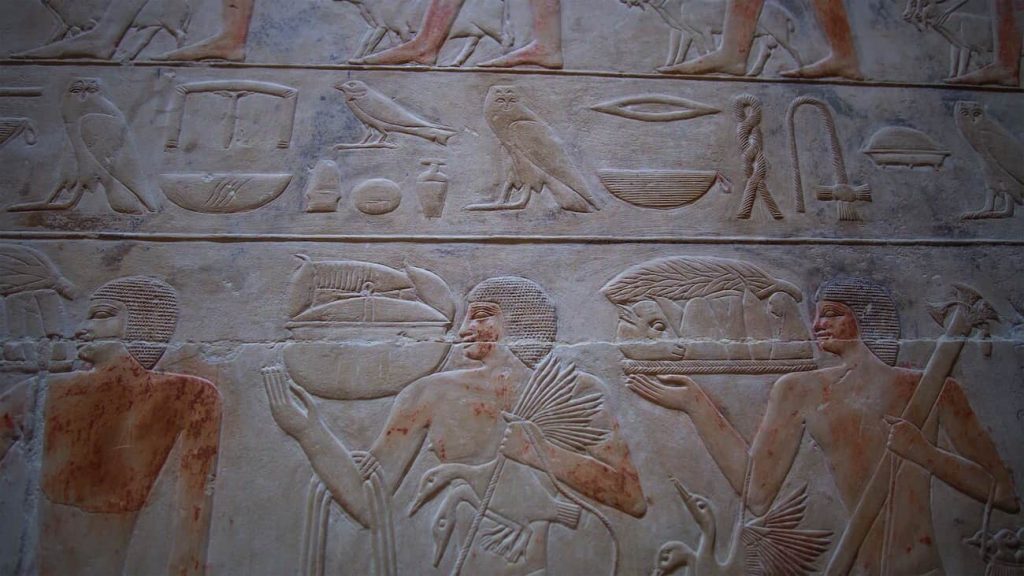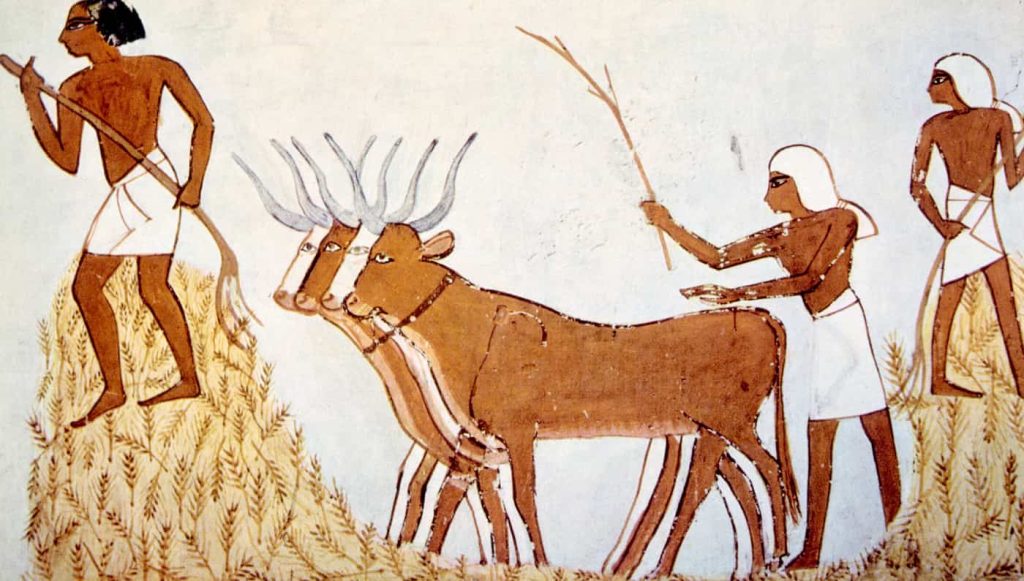Ancient Egyptian Agriculture: Facts about its Tools, and the Farmers.
The civilization of ancient Egyptian agriculture had a relationship with the Nile River and its dependable seasonal flooding. The Egyptians had a great agricultural wealth because of the river’s predictability and fertile soil. Egyptians were the first people to practice agriculture on a large scale because of the ingenuity of the Egyptians. As they developed basin irrigation. So they grow staple food crops, especially grains such as wheat and barley, and industrial crops, such as flax and papyrus.

Ancient Egyptian Agriculture
In the end, Ancient Egyptian agriculture developed a lot due to the cleverness of the Egyptians and the Nile River.
Ancient Egyptian Agriculture History
1- Beginnings of Ancient Egyptian Agriculture
- Eastern Sahara had several Neolithic cultures west of the Nile Valley. This area was a rich vegetation area during the African humid period. The population in the Sahara had increased significantly by about 8000 years BC. They lived by hunting and fishing in the local lakes and gathering wild cereals of the Sahara. The cereals were an important source of food, such as brachiaria, sorghum, and urochloa.

Egyptian Agriculture
- The African humid period ended about 6,000–5,000 years ago. The migrating herders were going to other places in Africa, but also coming to the Nile delta, where there were indications of agriculture before that.
- Then, Dakhleh Oasis was very important in the agricultural field because it supplied important evidence for early Egyptian agriculture. It was typical of post-Pleistocene developments in Northeastern Africa in general.
Dakhleh Oasis
- Dakhleh Oasis was in the Western Desert (Egypt). It lies 350 km (220 mi.) from the Nile between the oases of Farafra and Kharga. The Bashendi culture people were mobile herder-foragers in Dakhleh during the African humid period. They lived in slab-built settlement sites and open-air sites that consisted of clusters of hearth mounds. Bashendi-like groups have also lived in the Farafra Oasis, elsewhere in the Western Desert of Egypt, and at Nabta Playa. The Bashendi used sandstone grinders to grind local wild millet and sorghum.
- People found goat and cattle at the Farafra Oasis and Nabta. These animals were from 6100 BC (8100 cal BP) in the Hidden Valley village. Moreover, there were remains of sheep and goat from 6000 BC (8000 cal BP). The Faiyum Oasis of Egypt also had evidence for agriculture from about the same period, as there were sheep, goats, pigs, and cattle here.
- As for crops, there were emmer wheat and barley in the Faiyum at the sites of Kom K and Kom from 4500-4200 BC. In addition, there were many potteries at these sites, but there is no evidence yet.
All these were evidence of the beginning of agriculture in Egypt. These were all agricultural cultures.
2- The relationship between the Nile River and agriculture
How does Agriculture Depend on the Nile River?
The civilization of ancient Egypt developed in the arid climate of northern Africa. This region has the Arabian and Libyan deserts, and the Nile, which is the longest river in the world. Thus, the Egyptians benefit from the natural cyclical flooding pattern of the Nile. The Egyptians were able to develop their agricultural practices around it.

Egyptian countryside near the Nile irrigation canal
The water levels of the river would rise in August and September, and leave the floodplain and delta submerged by 1.5 meters of water at the peak of the flooding. As the floodwaters reduced in October, farmers had well-watered and fertile soil in which to plant their crops. The soil left behind by the flooding from silt was from the Ethiopian Highlands by the Nile River.
Planting was in October once the flooding finished. Crops grow with minimal care until they ripen between the months of March and May. While the flooding of the Nile was much more predictable and calm than other rivers, such as the Tigris and Euphrates, it was not always perfect. High floodwaters were destructive and could damage canals that were for irrigation. The lack of flooding made a very big disaster because it left Egyptians suffering from famine.
Irrigation Systems
The Egyptians developed systems of irrigation. Irrigation allowed the Egyptians to use the Nile’s waters for many purposes. Irrigation gave them control over their agricultural practices. Floodwaters were far from certain areas, such as cities and gardens, to keep them from flooding.
Irrigation was also to provide drinking water to Egyptians. Although irrigation was necessary to their agricultural success, there weren’t statewide regulations on water control. Rather, irrigation was the responsibility of local farmers.
However, there was the earliest and most famous reference to irrigation in Egyptian archaeology on the mace head of the Scorpion King, which was from 3100 BC. The mace head showed the king cutting into a ditch that is part of a grid of basin irrigation. The association of the king with irrigation highlights the importance of irrigation in Egypt
The Oldest Kind Of Irrigation
- Surface irrigation or gravity irrigation is the oldest form of irrigation. Ancient Egyptians used it for thousands of years.
- There is also sprinkler irrigation. Water is piped to one or more central locations within the field.
- In addition, Micro-irrigation is a system that distributes water under low pressure through a piped network and applies it in a small amount to each plant.
- Moreover, there is Subirrigation. They used them in field crops in areas with high water tables for many years.
Food Crops in Ancient Agriculture
The Egyptians cultivated various food crops, which included grains, together with vegetables and fruits. The Egyptians relied on staple crops primarily consisting of cereals and barley. The Egyptians cultivated einkorn wheat and emmer wheat as major grains, which they used to produce bread. The staple crops included beans and lentils, and later chickpeas and fava beans. The Egyptians cultivated root vegetables, including onions and garlic, and radishes, together with salad plants like lettuce and parsley.

Food crops in ancient Agriculture
The Egyptians grew the first fruits, like the palm date and sorghum. Then, more fruits appeared with other cultures, like Grapes and watermelon, as were the sycamore fig, date palm, and Christ’s thorn. The carob, olive, apple, and pomegranate appeared during the New Kingdom. Later, peaches and pears were popular in the Greco-Roman period.
Industrial and Fiber Crops:
Egyptians relied on agriculture for more than just the production of food. They also used agriculture for medicine in their religious practices and clothing.
They used herbs in cooking, medicine, as cosmetics, and in the process of embalming. So scientists have found over 2000 different species of flowering or aromatic plants in tombs. Papyrus was an extremely versatile crop that grew wild and was also cultivated.
People ate the roots of the plant as food, but they used it primarily as an industrial crop. The stem of the plant was used to make boats, mats, and paper. Flax was another important industrial crop that had many uses. Its primary usage was in the production of rope and for linen, which was the Egyptians’ principal material for making their clothing. They also grew henna to produce the dye.
Livestock During the Ancient Egyptian Agriculture Period.
Cattle
Ancient Egyptian cattle were of four principal types:
- 1- long-horned
- 2- Short-horned
- 3- Polled
- 4- Zebuine

Livestock during the Ancient Egyptian
The first evidence for existing cattle in Egypt was in the Faiyum region of the fifth millennium BC. There were also hump-backed zebuine cattle from Syria to Egypt that had replaced all types in the New Kingdom
Chickens
Manmade incubators, called Egyptian egg ovens. They were of the 4th century BC and were used to produce many chickens.
Cows
Cows were very important because they helped Egyptian farmers pull the plow, eat the leftover grain and wheat, trample the seeds, and provide them with milk.
Ancient Egyptian Agricultural Tools
The Egyptian farmers used tools that were not very different from those that exist today, such as:

Ancient Egyptian Agricultural Tools
1- Plow
The farmers employed a plow which they operated either manually or through a larger plow that a cow pulled. The plow functioned to rotate the soil, which distributed nutrients while creating accessible furrows for seed planting.
2- Hoe
The hoe functioned as a tool that combined features of both hammers and axes. The hoe served Egyptian farmers to break up the soil while they removed stones and loosened the earth. It consists of a basic design that includes a blade attached at a right angle to a long handle. The hoe maintained its status as an essential agricultural instrument throughout history and continues to be used in present times.
3- Axe and Sickle
The sickle was another important agricultural tool in ancient Egypt. This simple tool consists mostly of a handle and a blade. Its structure consists of a crescent-shaped blade attached to a short handle. Farmers used it for harvesting. While sickle blades are currently from iron, in ancient Egypt, they were from wood, and they sharpened the wooden blades to make them sharp.
4- Hand Plow
The hand plow served as an essential farming instrument for ancient Egyptian agricultural practices. The hand plow of ancient Egypt featured a wooden handle that supported two wooden blades with bronze tips, which served to break up the soil.
Plows serve farmers to rotate the soil, which enables modern agriculture to receive new nutrients. The lack of modern technology forced ancient Egyptian farmers to depend on their physical strength and traditional farming equipment. The ancient Egyptians occasionally employed oxen together with cows and donkeys to assist with plowing operations
5- Forks and Sifters
Ancient Egyptian agricultural tools were useful after the harvest. At this stage, ancient Egyptian farmers gathered the stalks of grain crops and took them to be threshed. Then, Donkeys spread the stalks and trampled them in the threshing room. Then, the women’s job is to use wooden forks to separate the grain from the chaff.
Ancient Egyptian Farmers
Most of the farmers from Ancient Egypt were peasants. When the pharaoh owned a farm, he would hire peasants to work for him. The farmers would take care of all the land, which was normally very big if a pharaoh owned it.

Villagers were also farmers. They would live in the towns and would take care of the land so they could eat and take care of their families.
Farming Seasons in Ancient Agriculture
There were two different seasons:
- The growing season
- The harvest season
During the growing season, the crops were planted in the land. This was a time of hard work where farmers would always have to ensure that the land was ready and that nothing was eating the crops. Since the farmers would farm close to the Nile River, water was not usually a problem.
During the harvest season, farmers would pick all of the crops and gather them for selling. This was another time of hard work, and farmers would work many hours a day preparing their crops
Religion and Ancient Agriculture
In ancient Egypt, religion had an important role in daily life. Many of the Egyptians’ religious observances depended on the environment, the Nile, and agriculture. They used religion as a way to explain natural phenomena, such as the cyclical flooding of the Nile and ancient agricultural yields.
Although the Nile was directly responsible for either good or bad fortune for the Egyptians, they did not worship the Nile itself. Rather, they thanked specific gods for any good fortune. They did not have a name for the river and referred to it as “River”. Thus, the term “Nile” is not of Egyptian origin.
Conclusion
Agriculture was extremely important to the ancient Egyptians because it contributed to the prosperity of their civilization. The ancient Egyptians were the first society to practice agriculture. The Egyptians developed many of the agricultural practices that are still in use today.
Agriculture is the world’s main source of food. It produces all basic foodstuffs. It produces vegetables, proteins, and oils. Agriculture also controls all harmful organisms.
Agriculture helps nations to develop. It is not just a means of producing food; it is also a source of livelihood, a development of the economy, and the environment. Through basic agricultural practices, we ensure food diversity and environmental conservation for future generations.
That’s why the Egyptians have always tried to develop it in the past and now.












